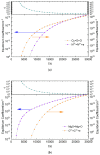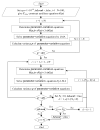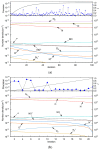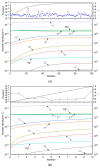Algorithms for Solving the Equilibrium Composition Model of Arc Plasma
- PMID: 39851644
- PMCID: PMC11765269
- DOI: 10.3390/e27010024
Algorithms for Solving the Equilibrium Composition Model of Arc Plasma
Abstract
In the present study, the Homotopy Levenberg-Marquardt Algorithm (HLMA) and the Parameter Variation Levenberg-Marquardt Algorithm (PV-LMA), both developed in the context of high-temperature composition, are proposed to address the equilibrium composition model of plasma under the condition of local thermodynamic and chemical equilibrium. This model is essentially a nonlinear system of weakly singular Jacobian matrices. The model was formulated on the basis of the Saha and Guldberg-Waage equations, integrated with Dalton's law of partial pressures, stoichiometric equilibrium, and the law of conservation of charge, resulting in a nonlinear system of equations with a weakly singular Jacobian matrix. This weak singularity primarily arises due to significant discrepancies in the coefficients between the Saha equation and the Guldberg-Waage equation, attributed to differing chemical reaction energies. By contrast, the coefficients in the equations derived from the other three principles within the equilibrium composition model are predominantly single-digit constants, further contributing to the system's weak singularity. The key to finding the numerical solution to nonlinear equations is to set reasonable initial values for the iterative solution process. Subsequently, the principle and process of the HLMA and PV-LMA algorithms are analyzed, alongside an analysis of the unique characteristics of plasma equilibrium composition at high temperatures. Finally, a solving method for an arc plasma equilibrium composition model based on high temperature composition is obtained. The results show that both HLMA and PV-LMA can solve the plasma equilibrium composition model. The fundamental principle underlying the homotopy calculation of the (n-1) -th iteration, which provides a reliable initial value for the n-th LM iteration, is particularly well suited for the solution of nonlinear equations. A comparison of the computational efficiency of HLMA and PV-LMA reveals that the latter exhibits superior performance. Both HLMA and PV-LMA demonstrate high computational accuracy, as evidenced by the fact that the variance of the system of equations ||F|| < 1 × 10-15. This finding serves to substantiate the accuracy and feasibility of the method proposed in this paper.
Keywords: HLMA; PV–LMA; arc plasma; equilibrium composition model.
Conflict of interest statement
Author Ningning Liu was employed by the company Longhua Technology Group (Luoyang) Co., Ltd. The remaining authors declare that the research was conducted in the absence of any commercial or financial relationships that could be construed as a potential conflict of interest.
Figures









Similar articles
-
[MEG inverse solution using Gauss-Newton algorithm modified by Moore-Penrose inversion].Sheng Wu Yi Xue Gong Cheng Xue Za Zhi. 2001 Jun;18(2):265-8. Sheng Wu Yi Xue Gong Cheng Xue Za Zhi. 2001. PMID: 11450550 Chinese.
-
Reduced formulation and efficient algorithm for the determination of equilibrium composition and partition functions of ideal and nonideal complex plasma mixtures.Phys Rev E Stat Nonlin Soft Matter Phys. 2004 Feb;69(2 Pt 2):026702. doi: 10.1103/PhysRevE.69.026702. Epub 2004 Feb 26. Phys Rev E Stat Nonlin Soft Matter Phys. 2004. PMID: 14995584
-
Intelligent Levenberg-Marquardt neural network solution to flow of carbon nanotubes in a nozzle of liquid rocket engine.Nanotechnology. 2023 Dec 4;35(8). doi: 10.1088/1361-6528/ad0e2c. Nanotechnology. 2023. PMID: 37983910
-
Cato Guldberg and Peter Waage, the history of the Law of Mass Action, and its relevance to clinical pharmacology.Br J Clin Pharmacol. 2016 Jan;81(1):52-5. doi: 10.1111/bcp.12721. Epub 2015 Oct 22. Br J Clin Pharmacol. 2016. PMID: 26174880 Free PMC article. Review.
-
Discovery of a general method of solving the Schrödinger and dirac equations that opens a way to accurately predictive quantum chemistry.Acc Chem Res. 2012 Sep 18;45(9):1480-90. doi: 10.1021/ar200340j. Epub 2012 Jun 11. Acc Chem Res. 2012. PMID: 22686372 Review.
References
-
- Wang X., Zhong L., Cressault Y., Gleizes A., Rong M. Thermophysical properties of SF6-Cu mixtures at temperatures of 300–30,000 K and pressures of 0.01–1.0 MPa: Part 2. Collision integrals and transport coefficients. J. Phys. D Appl. Phys. 2014;47:495201. doi: 10.1088/0022-3727/47/49/495201. - DOI
-
- Zhong L., Murphy A.B., Wang X., Rong M. Calculation of two-temperature plasma composition: I. Mass action law methods and extremum searching methods. J. Phys. D Appl. Phys. 2019;53:065202. doi: 10.1088/1361-6463/ab572d. - DOI
-
- Gleizes A., Gonzalez J.J., Freton P. Thermal plasma modelling. J. Phys. D Appl. Phys. 2005;38:R153. doi: 10.1088/0022-3727/38/9/R01. - DOI
-
- Murphy A.B. Thermal plasmas in gas mixtures. J. Phys. D Appl. Phys. 2001;34:R151–R173. doi: 10.1088/0022-3727/34/20/201. - DOI
-
- Wang W., Rong M., Spencer J.W. Nonuniqueness of two-temperature Guldberg-Waage and Saha equations: Influence on thermophysical properties of SF6 plasmas. Phys. Plasmas. 2013;20:113504. doi: 10.1063/1.4829035. - DOI
Grants and funding
LinkOut - more resources
Full Text Sources

